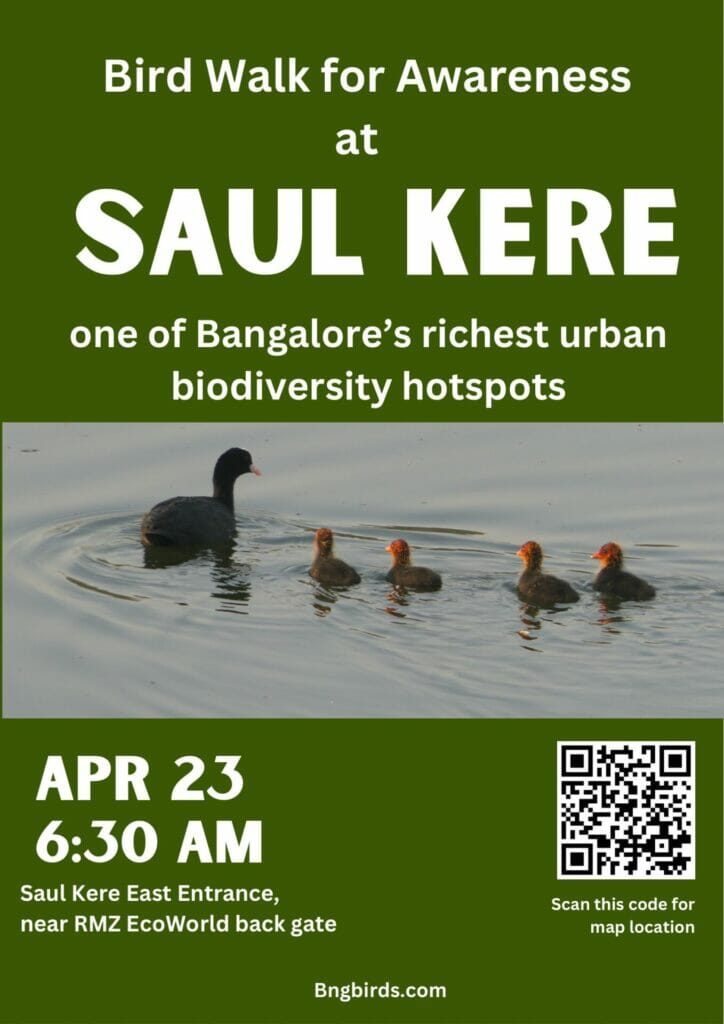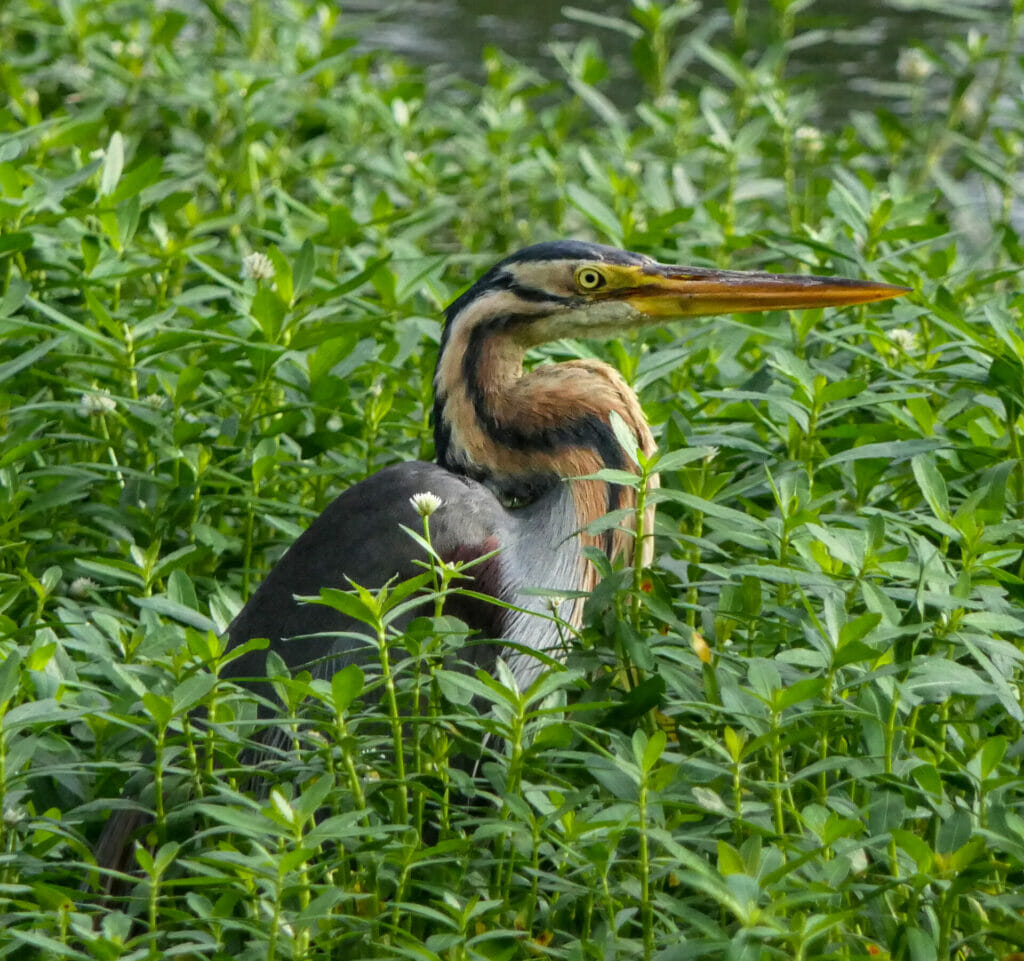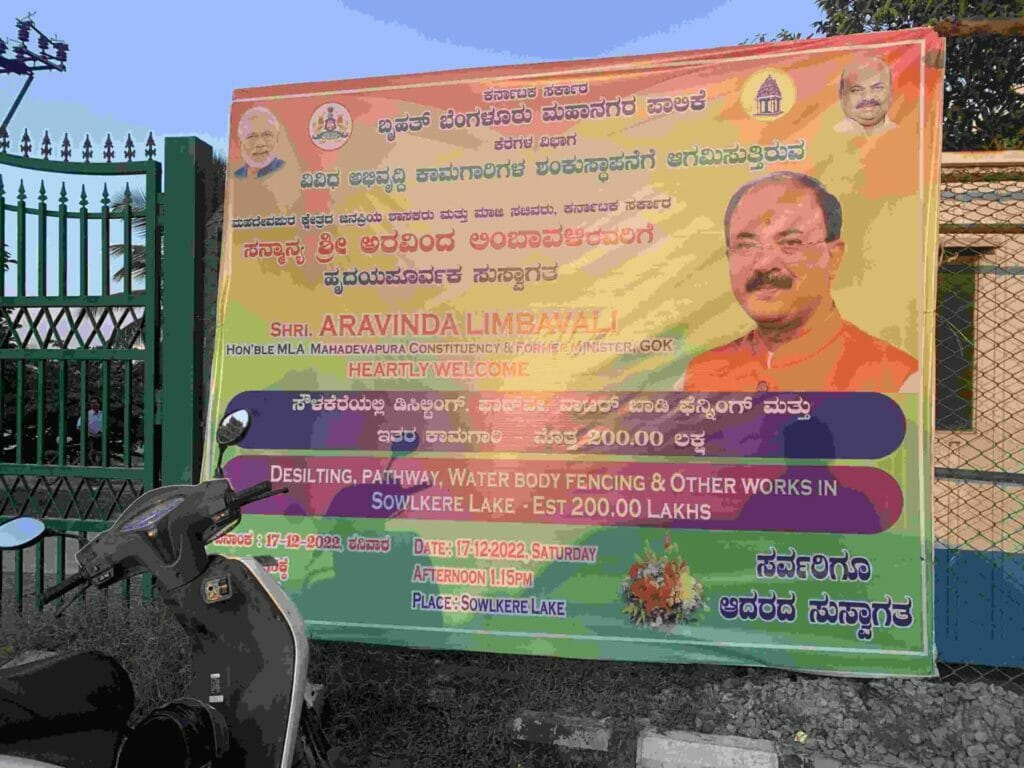BBMP’s ongoing project on Saul Kere, a lake off Sarjapur Road, is apparently meant to address flooding issues in the neighbourhood. But its implementation – desilting, pathway, waterbody fencing – started without any public consultation — indicates this could negatively affect the lake.
Saul Kere, part of a chain of lakes that drains into Bellandur Lake, is one of the richest biodiversity areas in urban Bengaluru. With its shallow-water areas, well-vegetated swamps, reed-beds, and woodlands in addition to the main water body, Saul Kere offers diverse habitats for birds, providing food and roosting sites for resident and migratory species alike. Over 200 bird species have been recorded here in the recent past.
Bngbirds, the city’s largest group of birdwatchers, is organising a bird walk on April 23 2023, to create awareness about Saul Kere. Through the walk, the city’s birding community aims to draw attention to the various micro-habitats and the threats to these microhabitats from poorly conceived lake management approaches.

Saul Kere, a biodiversity hotspot
Saul Kere (variably denoted as Sowl Kere or Soul Kere; Kannada ಸಾವಳ ಕೆರೆ), is a medium-sized urban wetland measuring about 23 Ha. It is administered by the Lakes department of Bruhat Bengaluru Mahanagara Palike (BBMP). Downstream from Kaikondrahalli Kere and upstream from Bellandur Kere, two major urban lakes, Saul Kere is connected to both by a Raja Kaluve — a traditional overflow channel linking water bodies to control flooding. The name of the lake, corrupted to Soul or Saul, derives from the Kannada word Saawala (ಸಾವಳ), meaning clay, and may be a reference to the natural soil of the lake bed.
Nature enthusiasts consider Saul Kere to be one of the richest biodiversity areas in urban Bengaluru. In addition to being a publicly accessible recreational green lung for all citizens, including walkers and joggers, it is treasured by the city’s birdwatching community as a birding hotspot with over 205 recorded bird species (as per eBird public data from more than 2,800 checklists) in addition to thousands of other taxa like insects and other arthropods, reptiles, amphibians, small mammals, as well as a variety of fungi, flowering plants, and trees documented on the citizen science portal iNaturalist.
For perspective, it’s important to consider this rich avian diversity in comparison to some of Karnataka’s most celebrated bird sanctuaries, such as Ranganathittu (230 species), Mandagadde (110 species) and Ghataprabha (96 species).

Bird diversity at Saul Kere
The presence of birds in an ecosystem is a vital indicator of its health. Birds are important agents of insect and rodent control, plant pollination, and seed dispersal, which result in tangible benefits to human populations.
Observing birds is also a recreational pursuit that is fast catching on, helping citizens appreciate the role of birds in the ecosystem, stoking curiosity and delight about their beauty, behaviour and habitats, and creating awareness that builds up to conscious environmental impact decisions and climate change action. In fact, during the COVID-19 pandemic, the number of people locked down at home started watching birds from their balconies or yards, and birding as a leisure pursuit grew substantially in popularity. The accessibility and popularity of the eBird app and platform have also contributed significantly to the increased interest in birding.
An unexpected sanctuary for migratory birds
The wetlands of peninsular India, including those in Bengaluru, fall within the migratory path of birds, known as flyways. A flyway is a flight path, spanning countries and continents and often oceans, used by large numbers of birds while migrating between their breeding grounds and their overwintering quarters. With climate change, many of these flyways are under threat, and the birds using them have become scarcer over the years. Saul Kere alone plays host to more than 200 recorded bird species throughout the year, among them resident and migratory species.
In addition to its position on the Asian Flyway, and owing to a combination of accidental and deliberate factors, Saul Kere has attracted more bird species than any other suburban lake in Bengaluru. Let’s try to understand why this is so.
Unlike many of the recently modernised lakes in Bengaluru, Saul Kere until recently retained a large area of shallow water and vegetation, which creates multiple microhabitats within the larger ecosystem. With a variety of shallow-water areas, well-vegetated swamps, reed-beds, and woodlands in addition to the main water body, Saul Kere offers diverse habitats for birds, providing food and roosting sites for resident and migratory species alike.
Environmental threats
In recent years, Saul Kere has been threatened by encroachment of the lake boundaries and untreated sewage inflow, which heavily compromise the quality and health of these diverse habitats available for biodiversity to thrive. Encroachments around the water body from construction, violation of fence boundaries, and raw sewage from multiple inlets, have caused the lake bed to fill up with garbage and debris, obstructing natural drainage channels.

The decline in the quality of water at Kaikondrahalli Lake (Google Maps location), upstream and southwest of Saul Kere, is an additional threat. Besides reducing water-holding capacity, toxins from raw sewage have resulted in fish kills at this lake, and similar threats apply to Saul Kere.
Predation by feral dogs, pigs and cats is an additional threat to nesting ground birds at Saul Kere, although this is not as serious as at other wetlands owing to the relative isolation of some of the avian habitats from the walking tracks.
Read more: Rainbow Drive — layout or lake? The man-made tragedy of Bengaluru’s flood-prone neighbourhoods
Pressure for desilting and deepening lakes like Saul Kere
During the Bengaluru floods of September 2022, Saul Kere overflowed onto the Outer Ring Road, flooding basements of residential and commercial properties, and causing damage to automobiles, electrical equipment and property worth crores of rupees. BBMP responded to the mounting public pressure by announcing a plan to desilt and deepen Saul Kere.

A flex banner with the BBMP logo appeared at the eastern entrance of Sowl Kere on December 17, 2022 declaring that Rs 200 lakh (Rs 2 crores) has been sanctioned for public works such as “desilting, pathway, water body fencing and other works”.
Experts have asserted time and again that desilting, dredging and de-weeding are expensive and unnecessary short-term fixes that do not address the root cause of flooding. A similar proposal to manage Sowl Kere was initiated in 2015 but was not completed. The BBMP has a track record of using unscientific short-term approaches to managing Bengaluru’s lakes, which have had disastrous consequences for many of our lakes, turning them into “soup bowls.”
As of March 2023, JCB excavators have been deployed to rake the lake bed. The BBMP has been approached several times to consider the concerns and suggestions raised by citizens.
Flaws of ‘Soup Bowl’ design approach
In a soup bowl design, steep walls are created around lakes with stone pitching and fences around the perimeters.
Paved walkways are often created, which prevent proper seepage and percolation of rainwater and create constraints for soil-dependent insects such as ants, beetles and wasps, as well as earthworms, snails, and certain non-venomous reptiles such as Brahminy Blind Snakes. Exotic tree species are planted and gardens are maintained using water from the lake.
Flawed island design is wasteful and expensive. Soil (usually clay) excavated from the deepened lake bed is used to construct islands and are often planted with trees. While islands offer suitable roosting habitats for birds, it is important to keep them isolated to prevent intrusion by humans or predation by feral dogs, cats and pigs. Scientific island design is vital for sustaining avian diversity in the lake and to create suitable habitats for bird species.
Absence of shallow foreshores, vital for sustaining wading birds dependent on shallow water and mudflats, are absent in soup bowl lakes. Such a design compromises the habitats necessary to sustain biodiversity and are not welcoming to migratory shorebirds, such as lapwings, sandpipers, stints, and plovers, which visit our lakes from distant Siberia and north-eastern Asia.
Puddling, as in creating watertight zones, is not a viable solution. Water remains trapped in the lakes, giving an outwardly aesthetic appearance but offering little of value to biodiversity, particularly bird life.
Such elements contravene the traditional design of these seasonal wetlands, eliminating the gradual foreshore and vegetation around them.
What can BBMP do better?
In order to better manage Saul Kere with a focus on making it a biodiversity hotspot in the heart of the city, it is highly recommended that the authorities, including the Government of Karnataka and BBMP, follow a consultative approach with citizen stakeholders to manage the lake. A few suggestions are as follows:
- Public consultation and approval: Make public the plan for developing the lake, with details of expenditure and timelines of every stage of work, with public consultation at every step.
- Improved focus on biodiversity conservation. Although freshwater covers less than 1% of the planet’s surface, more than 50% of the human population lives within 3km of a freshwater body. The Living Planet Report 2022, the World Wildlife Fund’s flagship publication released every two years, is a comprehensive study of trends in global biodiversity and the health of the planet. It shows an average global decline of 69 per cent in wildlife populations since 1970, thus emphasising the dual crises of biodiversity loss and climate change driven by human activities. Given these criteria, it is important for the BBMP to adopt measures to secure the future of our wetlands and freshwater resources with a focus on conserving biodiversity at Saul Kere.
- Halt pollution through law enforcement: The Water (Prevention and Control of Pollution) Act, 1974 mandates that strict measures be enforced to stop pollution of water bodies. In this context, the inflow of raw untreated sewage into the wetland must be stopped and the perpetrators must face legal action. Sewage must be diverted around the water body without mixing with the lake water. Only treated water and rainwater/stormwater inflow into the lake must be allowed with suitable catchment nets to prevent garbage and debris from being deposited in the lake bed.
- Consult experts for ecological management of Saul Kere and other neighbouring wetland ecosystems: Consult with well-regarded ecologists and wetland management experts, in addition to birdwatchers and nature enthusiasts of the city who play a significant role in the stewardship of the lake, prior to initiating any development plan.
- Give primacy to wetland ecology for improving biodiversity: Ensure that an ecologically sound development plan is approved by these stakeholders and carried out, ensuring preservation of woodlands, swamps, grasslands, marshes, wetlands and sloping foreshore areas of the water body, in addition to a central deep water area, in order to provide suitable habitats for a variety of birds, including shorebirds, water birds, woodland birds, and grassland birds. One-third of the lake area should be occupied by floating vegetation, as it plays a vital role in bioremediation.
- Stone-pitching on the sides of Walking/Jogging Track: The sides of the Jogging track should have a very gradual slope (20-30 degrees) and the lower section of the stone-pitched slope should be covered in mud, as shown in the figure above. These slopes offer potential nesting sites for Bee-eaters, Hoopoes as well as Common Kingfishers and Pied Kingfishers, birds whose populations have seen a decline in recent years.
- Sloping of stone-lined edges should be at 1:7 not 1:1 or 1:3. The slope of the margin needs to be gentle and not steep, to suit the slope margin requirements of different birds.
- Slope ridging: Slopes should not be continuous; they should have furrows and ridges to hold plants perpendicular to the edge of the shore.
- No paved walkways: Paving the walkways does not allow water to seep into the ground effectively and is also disadvantageous to ants, wasps and other creatures that are dependent on soil. Instead of paved walkways, packed soil with gravel and sand are more effective and also friendly to walkers and joggers.
- Shoreline length: The length of the shoreline should be increased through interventions.
- Island design: Rather than construct circular islands, it is recommended that the islands be of a split-ring design with sloping as described above to accommodate the needs of bird species.
- Reduce wind turbulence over water by allowing the growth of reeds and floating vegetation, which enable ripple-stopping.
- Bioremediation can take place only by encouraging plant growth. There is no effective cost-effective engineering solution to nitrogen removal other than plant growth in the lake.
- Control of invasive species: Ensure that invasive species of plants or animals (including exotic fish species) are not released or cultivated in the lake.
- Transparency of progress reports: Ensure that project progress and expenditure reports of the proposed development are announced transparently and approved by a representation of concerned citizens and carried out to completion.
- Clear encroachments on Raja Kaluve to prevent future flooding: Increase the current size/depth of untreated sewage diversion lines in order to avoid future inundation. The drain size adjacent to EcoSpace, in particular, must be widened to accommodate the excess outflow during periods of high rainfall.
- Public-private participation for maintenance and stewardship: Institute a citizen-led committee to maintain the wetland in a condition amenable for supporting biodiversity, with periodic testing and monitoring of water quality as well as vegetation and biodiversity surveys.
- Raise the height of the overflow weir by 1 foot to prevent incidental overflows and retain water in the lake catchment.
The above measures will help Saul Kere retain its unique biodiversity while fulfilling its purpose as an urban wetland ecosystem and public commons.
Citizens who wish to know more are invited to join the free bird walk on April 23rd to learn more about the threats to Saul Kere’s future as a biodiversity hotspot and birding destination, as well as to examine some of the current works underway at the lake and understand their likely consequences.
A detailed version of this post is available on The Green Ogre.